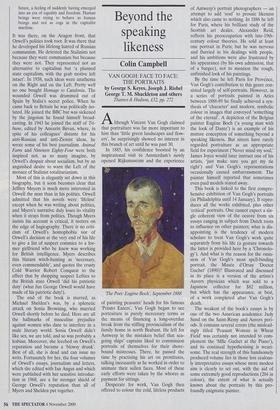Beyond the speaking likeness
Colin Campbell
VAN GOGH: FACE TO FACE: THE PORTRAITS by George S. Keyes, Joseph J. Rishel George T. M. Shackleton and others Thames & Hudson, £32, pp. 272 Although Vincent Van Gogh claimed that portraiture was far more important to him than 'little green landscapes and flow- ers', he surprisingly showed no interest in this branch of art until he was past 30.
In 1885, his confidence boosted by an inspirational visit to Amsterdam's newly opened Rijksmuseum and the experience of painting peasants' heads for his famous `Potato Eaters', Van Gogh began to see portraiture in purely mercenary terms as the means of financing a long-overdue break from the stifling provincialism of the family home in north Brabant. He left for Antwerp in the mistaken belief that sea- going ships' captains liked to commission portraits of themselves for their shore- bound mistresses. There, he passed the time by practising his art on prostitutes, talking incessantly as he worked in order to animate their sullen faces. Most of these early efforts were taken by the whores as payment for sittings.
Desperate for work, Van Gogh then offered to colour the cold, lifeless products of Antwerp's portrait photographers — an attempt to add 'soul' to prosaic likeness which also came to nothing. In 1886 he left for Paris, where his brilliant study of the Scottish art dealer, Alexander Reid, reflects his preoccupation with late-19th- century colour theories. He sold at least one portrait in Paris; but he was nervous and flurried in his dealings with people, and his ambitions were also frustrated by his appearance (by his own admission, that of a bargee), not to mention the rough, unfinished look of his paintings. By the time he left Paris for Provence, Van Gogh's contribution to this genre con- sisted largely of self-portraits. However, in a series of portraits painted in Arles between 1888-89 he finally achieved a syn- thesis of 'character' and modern, symbolic colour in images that conveyed 'something of the eternal'. A depiction of the Belgian painter Eugene Boch Ca young man with the look of Dante') is an example of his mature conception of something beyond a speaking likeness. But sitters have rarely regarded portraiture as an appropriate field for experiment (Never mind my soul,' James Joyce would later instruct one of his artists, 'just make sure you get my tie right') and Van Gogh's representations occasionally caused embarrassment. The painter himself reported that sometimes even paid models stayed away.
This book is linked to the first compre- hensive exhibition of Van Gogh's portraits (in Philadelphia until 14 January). It repro- duces all the works exhibited, plus other `critical' portraits. One cannot expect a sin- gle coherent view of the oeuvre from six essays ranging in subject from Dutch roots to influence on other painters; what is dis- appointing is the tendency of modern scholars to treat Van Gogh's work quite separately from his life (a gesture towards the latter is provided here by a `Chronolo- gy'). And what is the reason for the omis- sion of Van Gogh's most spell-binding portrait, the Musee d'Orsay 'Doctor Gachet' (1890)? Illustrated and discussed in its place is a version of the artists's Anvers physician which was sold to a Japanese collector for $82 million, but which has the appearance, at best, of a work completed after Van Gogh's death.
The weakest of the book's essays is by one of the two American academics: Judy Sund on the Saint-Remy and Auvers peri- ods. It contains several errors (the mislead- ingly titled 'Peasant Woman in Wheat Field' was certainly not intended to com- plement the 'Mlle Gachet at the Piano'), and its continual hypothesising is weari- some. The real strength of this handsomely produced volume lies in those less zealous- ly interpretative essays whose more modest aim is clearly to set out, with the aid of some extremely good reproductions (204 in colour), the extent of what is actually known about the portraits by this pro- foundly enigmatic painter.


























































































 Previous page
Previous page